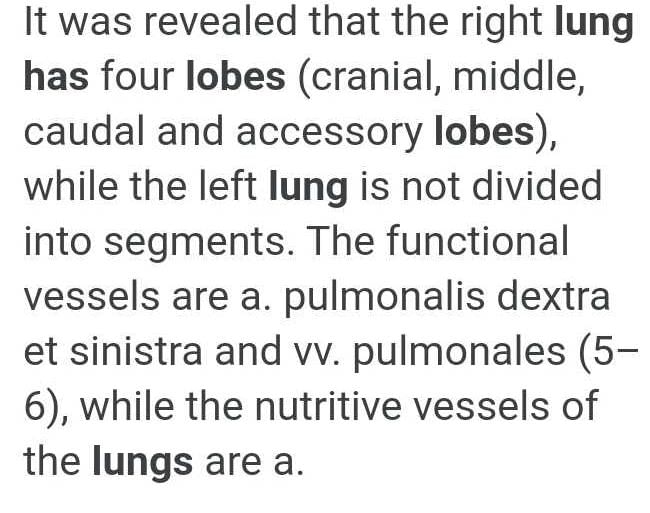NEET Exam > NEET Questions > The lungs of squirrel has______ lobes, wherea...
Start Learning for Free
The lungs of squirrel has______ lobes, whereas in man the number of lobes of lungs is five and rabbit is (4+2)
- a)Five
- b)Four
- c)Three
- d)Two
Correct answer is option 'A'. Can you explain this answer?
Most Upvoted Answer
The lungs of squirrel has______ lobes, whereas in man the number of lo...

Community Answer
The lungs of squirrel has______ lobes, whereas in man the number of lo...
The lobular division, bronchial tree, and blood vessels in lungs of seven squirrel monkeys (Saimiri sciureus) were examined from the viewpoint of comparative anatomy. The right lung of the squirrel monkey consists of the upper, middle, lower, and accessory lobes, whereas the left lung consists of the upper, middle, and lower lobes. These lobes are completely separated by interlobular fissures. In three of seven examples examined the left middle lobe was lacking. The squirrel monkey lung has four bronchiole systems, i.e. dorsal, lateral, ventral, and medial, on both sides. The upper lobes are formed by the first branches of the dorsal bronchiole systems. The middle lobes are formed by the first branches of the lateral bronchiole systems. The remaining bronchioles constitute the lower lobes. In addition to the above lobes, in the right lung, the accessory lobe is present, being formed by the first branch of the ventral bronchiole system. The right pulmonary artery runs across the ventral side of the right upper lobe bronchiole, and then across the dorsal side of the right middle lobe bronchiole. Thereafter, it runs between the dorsal bronchiole and lateral bronchiole systems along the dorso-lateral side of the right bronchus. During its course, the right pulmonary artery gives off the arterial branches which run along each bronchiole. These branches run mainly along the dorsal or lateral side of the bronchioles. In the left lung, the pulmonary artery and its branches run the same course as in the right lung. The pulmonary veins run mainly the ventral or medial side of the bronchioles, and between the bronchioles.

|
Explore Courses for NEET exam
|

|
Similar NEET Doubts
The lungs of squirrel has______ lobes, whereas in man the number of lobes of lungs is five and rabbit is (4+2)a)Fiveb)Fourc)Threed)TwoCorrect answer is option 'A'. Can you explain this answer?
Question Description
The lungs of squirrel has______ lobes, whereas in man the number of lobes of lungs is five and rabbit is (4+2)a)Fiveb)Fourc)Threed)TwoCorrect answer is option 'A'. Can you explain this answer? for NEET 2025 is part of NEET preparation. The Question and answers have been prepared according to the NEET exam syllabus. Information about The lungs of squirrel has______ lobes, whereas in man the number of lobes of lungs is five and rabbit is (4+2)a)Fiveb)Fourc)Threed)TwoCorrect answer is option 'A'. Can you explain this answer? covers all topics & solutions for NEET 2025 Exam. Find important definitions, questions, meanings, examples, exercises and tests below for The lungs of squirrel has______ lobes, whereas in man the number of lobes of lungs is five and rabbit is (4+2)a)Fiveb)Fourc)Threed)TwoCorrect answer is option 'A'. Can you explain this answer?.
The lungs of squirrel has______ lobes, whereas in man the number of lobes of lungs is five and rabbit is (4+2)a)Fiveb)Fourc)Threed)TwoCorrect answer is option 'A'. Can you explain this answer? for NEET 2025 is part of NEET preparation. The Question and answers have been prepared according to the NEET exam syllabus. Information about The lungs of squirrel has______ lobes, whereas in man the number of lobes of lungs is five and rabbit is (4+2)a)Fiveb)Fourc)Threed)TwoCorrect answer is option 'A'. Can you explain this answer? covers all topics & solutions for NEET 2025 Exam. Find important definitions, questions, meanings, examples, exercises and tests below for The lungs of squirrel has______ lobes, whereas in man the number of lobes of lungs is five and rabbit is (4+2)a)Fiveb)Fourc)Threed)TwoCorrect answer is option 'A'. Can you explain this answer?.
Solutions for The lungs of squirrel has______ lobes, whereas in man the number of lobes of lungs is five and rabbit is (4+2)a)Fiveb)Fourc)Threed)TwoCorrect answer is option 'A'. Can you explain this answer? in English & in Hindi are available as part of our courses for NEET.
Download more important topics, notes, lectures and mock test series for NEET Exam by signing up for free.
Here you can find the meaning of The lungs of squirrel has______ lobes, whereas in man the number of lobes of lungs is five and rabbit is (4+2)a)Fiveb)Fourc)Threed)TwoCorrect answer is option 'A'. Can you explain this answer? defined & explained in the simplest way possible. Besides giving the explanation of
The lungs of squirrel has______ lobes, whereas in man the number of lobes of lungs is five and rabbit is (4+2)a)Fiveb)Fourc)Threed)TwoCorrect answer is option 'A'. Can you explain this answer?, a detailed solution for The lungs of squirrel has______ lobes, whereas in man the number of lobes of lungs is five and rabbit is (4+2)a)Fiveb)Fourc)Threed)TwoCorrect answer is option 'A'. Can you explain this answer? has been provided alongside types of The lungs of squirrel has______ lobes, whereas in man the number of lobes of lungs is five and rabbit is (4+2)a)Fiveb)Fourc)Threed)TwoCorrect answer is option 'A'. Can you explain this answer? theory, EduRev gives you an
ample number of questions to practice The lungs of squirrel has______ lobes, whereas in man the number of lobes of lungs is five and rabbit is (4+2)a)Fiveb)Fourc)Threed)TwoCorrect answer is option 'A'. Can you explain this answer? tests, examples and also practice NEET tests.

|
Explore Courses for NEET exam
|

|
Signup for Free!
Signup to see your scores go up within 7 days! Learn & Practice with 1000+ FREE Notes, Videos & Tests.
























